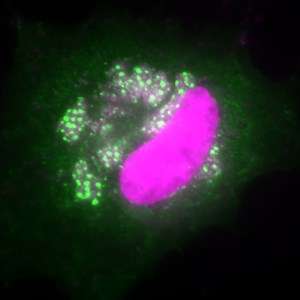Pox virus discovery has implications for vaccines and cancer

Scientists at the Francis Crick Institute have made a surprising discovery about the Vaccinia virus, a large DNA virus belonging to the pox family that was used as the vaccine to eradicate smallpox.
Today, the Vaccina virus is being developed and used in vaccines for a number of other diseases and in immunotherapy to treat cancer.
Contrary to previous assumptions, the Crick team found that the Vaccinia virus needs proteins from the host cells it infects to replicate.
Michael Way of the Crick explains: "Poxviruses, unlike other DNA viruses such as herpesviruses, do not replicate in the cell nucleus, where the host's DNA replication machinery is located. Instead, it was previously thought that Vaccinia replicates its DNA outside the nucleus, in the host cell's cytoplasm because it does not require any factors from the cell as it only uses viral proteins."
Dr Way's team infected cells with Vaccinia and used microscopy to look at where a number of host cell proteins involved in replicating and repairing DNA were localised after infection. They also looked at what happened to the virus's ability to replicate when they removed proteins involved in the host cell's usual response to DNA damage.
They discovered that Vaccinia does in fact use host proteins, alongside viral proteins, to replicate its DNA.
One of these proteins, called ATR, is involved in overcoming damage to our DNA caused by chemicals, UV light or replication errors. The scientists found that ATR might promote viral DNA replication in a similar way to its normal role in preventing damage caused by errors in DNA replication.
Dr Way says: "From a basic science point of view, our work has now opened up using Vaccinia as a new model system to provide further insights into the role of ATR in regulating DNA replication and in maintaining DNA integrity during the DNA damage response.
"With the eradication of smallpox, the development of anti-poxviral strategies has not evolved much. Yet, outbreaks of monkeypox in the USA, for instance, highlight the continued risk this family of viruses might cause in the future. Therefore, having access to anti-poxviral agents remains of interest. So far, such agents have always targeted pox viral proteins. Our findings indicate that drugs targeting host molecules involved in DNA replication, damage and repair might be repurposed to protect against poxvirus infection."
The research also has implications for cancer immunotherapy using the Vaccinia virus. Dr Way adds: "Recent thinking favours combining Vaccinia immunotherapy with conventional anti-tumour therapies for maximal effect. However, such therapies should not decrease the virus's ability to replicate inside a tumour, which is a key factor for efficacy against cancer. Our work therefore suggests that poxvirus therapy should not be combined with chemical inhibitors of ATR, and possibly other inhibitors of the DNA damage response, as this may weaken viral replication."
More information: Antonio Postigo et al. Cytoplasmic ATR Activation Promotes Vaccinia Virus Genome Replication, Cell Reports (2017). DOI: 10.1016/j.celrep.2017.04.025
Journal information: Cell Reports
Provided by The Francis Crick Institute



















